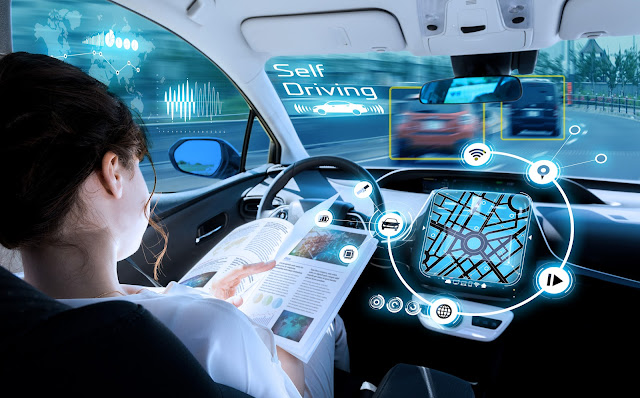Welcome to the future of automotive engineering, where Artificial Intelligence (AI) is driving unprecedented advancements and reshaping the industry. From enhancing safety to revolutionizing the driving experience, AI is the engine powering the next generation of vehicles.
In
this article, we delve into the top five AI innovations that are transforming
the automotive industry in 2024, showcasing how these advancements are paving
the way for a smarter, safer, and more efficient future.
1. Autonomous Driving Systems
Revolutionizing Transportation
Autonomous
driving systems are perhaps the most significant AI-driven innovation in the
automotive industry. Companies like Tesla, Waymo, and Uber are at the
forefront, developing sophisticated AI algorithms that enable vehicles to
navigate roads without human intervention.
Key
Components:
Perception
Systems:
Utilizing AI to process data from cameras, radar, and LiDAR to understand the
vehicle's environment.
Decision-Making
Algorithms:
Advanced machine learning models that make real-time driving decisions based on
sensor data.
Path
Planning:
AI systems that determine the most efficient and safe route from point A to
point B.
Impact: Autonomous vehicles
promise to reduce traffic accidents, decrease congestion, and provide mobility
solutions for those unable to drive. With advancements in AI, these vehicles
can learn and adapt to complex driving environments, ensuring safer and more
reliable transportation.
2. Predictive Maintenance
Enhancing Vehicle Reliability
Predictive
maintenance leverages AI to predict when a vehicle component is likely to fail,
allowing for proactive maintenance. This innovation helps in reducing downtime,
extending vehicle lifespan, and lowering maintenance costs.
Key
Technologies:
IoT
Sensors:
Collect real-time data on vehicle performance and health.
Machine
Learning Models:
Analyze data to predict component failures before they occur.
Benefits: Predictive
maintenance enhances the reliability and safety of vehicles, ensuring they are
always in optimal condition. By predicting issues before they become serious
problems, AI helps in maintaining smooth and efficient vehicle operations,
which is crucial for both individual owners and fleet managers.
3. AI-Enhanced Driver Assistance
Systems
Improving Driving Safety
AI-powered
Advanced Driver Assistance Systems (ADAS) are designed to improve driving
safety by assisting with various driving tasks. Features like adaptive cruise
control, lane-keeping assistance, and automatic emergency braking are becoming
standard in modern vehicles.
Key
Features:
Adaptive
Cruise Control:
Uses AI to adjust vehicle speed based on traffic conditions.
Lane-Keeping
Assistance:
AI algorithms help keep the vehicle within lane markings.
Automatic
Emergency Braking:
Detects potential collisions and applies brakes autonomously.
Impact: ADAS reduces the
likelihood of accidents, providing a safer driving experience for all road
users. These systems leverage AI to analyze vast amounts of data in real-time,
making split-second decisions that can prevent accidents and save lives.
4. AI-Based Traffic Management Systems
Optimizing Traffic Flow
AI
is not just limited to individual vehicles; it also plays a crucial role in
managing traffic flow. AI-based traffic management systems analyze real-time
traffic data to optimize traffic signals, reduce congestion, and improve
overall traffic efficiency.
Key
Technologies:
Real-Time
Data Analytics:
AI processes data from traffic cameras, sensors, and GPS devices.
Predictive
Modelling:
Anticipates traffic patterns and adjusts traffic signals accordingly.
Benefits: Improved traffic
flow, reduced travel time, and decreased fuel consumption contribute to a more
efficient and eco-friendly transportation system. AI-based traffic management
can significantly alleviate urban congestion, leading to smoother and faster
commutes.
5. AI-Powered In-Car Assistants
Enhancing User Experience
AI-powered
in-car assistants, like Apple's Siri, Amazon's Alexa, and Google's Assistant,
are transforming the in-car experience. These virtual assistants provide
voice-activated controls, navigation assistance, and even entertainment
options, making driving more convenient and enjoyable.
Key
Features:
Voice
Recognition:
Allows drivers to control vehicle functions using voice commands.
Personalized
Recommendations:
AI learns user preferences and provides tailored suggestions.
Connectivity: Seamless integration
with other smart devices and services.
Impact: AI-powered in-car
assistants enhance convenience and safety, allowing drivers to stay focused on
the road while enjoying a more connected and personalized driving experience.
These systems are continually learning from user interactions, making them more
intuitive and user-friendly over time.
The
automotive industry is accelerating into the future with these groundbreaking
AI innovations. Autonomous driving systems, predictive maintenance, AI-enhanced
driver assistance, AI-based traffic management, and AI-powered in-car
assistants are just the beginning. As these technologies continue to evolve,
they promise to make our roads safer, our journeys more efficient, and our
driving experiences more enjoyable.
Stay updated with the latest trends in
automotive AI and support the integration of these technologies for a smarter,
safer future. Follow Mech Synergy for more insights and advancements in the
world of automotive engineering and AI technology.
Read: 5 Reasons Why Autonomous Vehicles Fail: Challenges in Self-Driving Technology








Comments
Post a Comment